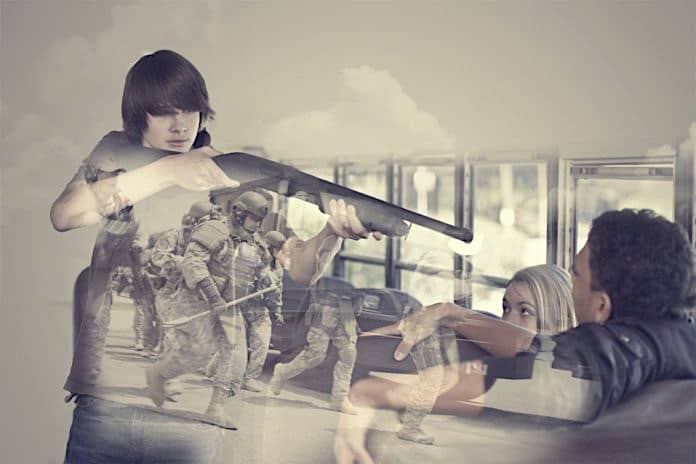It is a well-known fact that school buses are considered “soft” targets vulnerable to armed adults and students bent on destruction. Mass murders have occurred inside school buildings, and school buses offer less protection for its occupants in terms of fewer options for escape. The run, hide, fight scenario is almost non-existent on a school bus if an active shooter gains access. Occupants are forced to go immediately to option three. Only the bus driver stands between the perpetrator and the innocent students, as was the case in January 2013 with Chuck Poland, just six weeks after Sandy Hook.
He was shot and killed while attempting to protect his students from an armed man trespassing on the bus to kidnap several students. After shooting Poland to death, he did abduct a 5-year-old boy and held him hostage for nearly a week in an underground bunker before he was rescued by the FBI.
This is not a recent phenomenon, but it is no less disturbing. Consider the 1976 bus hijacking kidnapping of 26 children ages 5 to 14 years and their bus driver, Frank Edward Ray in Chowchilla, California. The group was buried inside a moving van in a quarry and held for ransom. They escaped when Edwards and several students tunneled their way out 16 hours later.
Eleven years ago in March, Joyce Gregory, a bus driver for Stewart County Schools in Dover, Tenn., died at the scene after she was shot multiple times by a 14-year-old student with a .45 caliber automatic handgun. Clinard was reportedly upset at being suspended from the bus ride for three weeks that semester and for Gregory reporting him to school administrators the day prior for using smokeless tobacco and fighting on the bus.
School districts have begun providing critical training to bus drivers to avoid getting into situations where they or their students are endangered. Drivers are also being trained to initiate options when confronted by an active shooter, where before there appeared to be no options. The training includes recognizing situations that do not appear right; preventing unauthorized persons from entering the bus; de-escalation; using tactical driving maneuvers to keep active shooters off balance before subduing them and disarming them as a last resort. The training is provided by law enforcement professionals and by companies that specialize in active shooter training.
School officials are using the training classes as a proactive way of dealing with a situation they hope never happens.
“We did this because of everything that’s been in the news,” said Ken Hood, superintendent of the Mountain Union Elementary District in northern California. “The potential for a problem is higher now than 20 years ago. One big reason we trained the whole staff is because it changes your attitude. Your only other choice is to say I’m going to die and you get passive. When you’re trained in how shooters think, the trainers let you know you have more choices. The shooters are scared themselves, they are very unstable people. When you know you have power over them you are much more capable of protecting yourself and protecting the kids.”
The Mountain Union Elementary School District is a one-school district in Northern California, about an hour south of Mt. Shasta. It has 84 students enrolled in transitional kindergarten through eighth grade with 23 staffers. In addition to busing its students, the district provides transportation to preschoolers.
Hood included his four bus drivers in a training class that taught them negotiating and self-defense techniques that he said could save their lives and the lives of students when all other options have been exhausted.
“Every time I heard about (a shooting) I thought what can we do?” Hood recounted. “I felt helpless. Then I went to the bus training and learned that in the direst situations where you’re on a bus and someone has a gun in your face there is something you can do.”
Kelly Knapp, transportation director for the Storey County School District in Virginia City, Nevada, said she put her drivers through the training because her district is in an “extremely rural” area that is a major tourist attraction. “We have unmarked roads going in and out of canyons, hills and mountains,” she said. “I was concerned about someone blocking a road and taking a bus hostage. It would be really easy for someone to come in here and take a bus or destroy a bus and exit a different way off the mountain.”
Knapp also said that because the area is a major Wild West tourist attraction — Virginia City, a boomtown of the 1859 Comstock Lode — where to this day it can be difficult to tell the good guys from the bad. “We have a lot of people in town milling around. We’re so rural that really anything can happen. We’re trying to be proactive.”
Knapp said the drivers went through drills such as hostage awareness, disarming a trespasser of a weapon and active shooter drills. “It was definitely informative.”
The New Caney ISD just north of Houston, transports about 8,000 students a day using more than 100 bus drivers. Officials there also opted for the active shooter training before anything happened. “(We) wanted to be proactive and equip our drivers with the necessary tools and training to be the best they can at the great job they do each and every day while keeping our kids safe,” said Josh Rice, the district’s director of transportation. “When you conduct training and practice scenarios, you’re more likely to use your training and take charge should it become necessary to use. In today’s changing world, I don’t think you can “over-train” your staff to be ready for any situation.”
Ruben Parra, transportation assistant supervisor for Montgomery County Schools in Salinas, California, said gang activity was the reason his district hosted a classroom training session in October for about 125 special needs drivers. He said some of the neighborhoods are wracked by gang violence.
“We want to protect the drivers, you never know what they will encounter,” Parra said. “We provide door-to-door service and we’ve had a situation where a driver turned down a one-way street in a neighborhood and a shooting occurred right in front of the driver.”
Parra said other drivers have reported seeing muzzle flashes from passing cars. “Our drivers are required to have 10 hours of training a year so we decided to do something with safety,” Parra said. “This was only a half day in the classroom and we got a lot of positive feedback.”
Trainers
Most companies and associations that provide active shooter and de-escalation training agree that the best method is prevention.
Bob Rettmann, the director of research and communication for the Crisis Prevention Institute, said shooters grab the headlines but those instances are rare. “The training we teach is intervening before it escalates,” Rettmann said. “Shooters are on a very rare scale. We teach day to day skills for staff on what to do when peoples’ behavior changes. We can provide support to de-escalate that behavior or take the approach that the behavior is not going to be that productive for them.”
Jeff May, president of APEX-SCF, uses a hands-on approach to training that actively involves the bus driver in training exercises that require them to react to situations enacted by the trainers during live drills. These include dealing with an irate parent at a bus stop and reacting to the sound of gunfire from the back of the bus and using tactical driving maneuvers to help subdue the shooter. May said watching a demonstration is not the same as participating. He echoed the opinion of other trainers by saying that if bus drivers practice the techniques enough, they will perform them in pressure situations without hesitation.
Bret Brooks, an instructor for Gray Ram Tactical, said the threat of parental kidnapping is one of the most common issues a bus driver will face. “The bus driver may know this is the kid’s parent but not know there are custody issues,” Brooks said. “This threat information does not get passed down to the bus driver in many cases.”
Brooks suggested that school districts should take a closer look at the hiring process to get the right people. “I think in the interview process you must pose the question how would you handle this type of event,” Brooks added. ”If you don’t hire the person who has the mentality to deal with these situations, they won’t have the confidence or mindset to deal with them.”
Armed or Unarmed?
Some security experts and many school administrators said they hope the increased emphasis on training will obviate the discussions on whether to arm bus drivers. In several states where some school districts allow concealed carry by unidentified school personnel, bus drivers are neither exempt nor are they specifically designated. Trainers and security experts either approach the topic with caution or eschew it totally as a bad idea.
“My personal view is the answer to this problem is not to pass out the pistols and win the gunfight,” said Tom Foley, assistant professor at the Embry-Riddle College of Security and Intelligence in Prescott, Ariz., and an expert on physical security. “That decision should be driven by law enforcement response time. If it is going to be 15 minutes or more for the police to arrive then that risk may warrant arming somebody, but they should be trained on the appropriate use of force and how to shoot in a tactical situation as opposed to a two-hour course on gun safety.”
Kevin Quinn, the former president of the National Association of School Resource Officers and a 20-year career SRO in Arizona, recently wrote an article that addresses arming school staff. He said he wrote the article based on facts so people can come to their own conclusion. “And that conclusion is that it is not a good idea,” Quinn said. Obviously in rural situations school districts will have to make a decision as to what’s in their best interest, especially if they do not have a police officer assigned as an SRO.”
Utah allows school staff to carry concealed weapons at school as long as they are certified. Murrell Martin, pupil transportation director for the Utah Department of Education said the law has been in effect for a couple years and was passed in response to school shootings and legislative involvement. Martin, who is certified for concealed carry, said some bus drivers were certified before the law was passed. “I can’t say who it is carrying but a bunch more (bus drivers) have gotten certified since the law went into effect,” he said. “It created a bit of a stir when it happened. Some felt it should be disclosed who is carrying. Others have the attitude that bad guys need to find out for themselves who is carrying and who is not.”
Gary Moore, safety coordinator at the Missouri Center for Educational Safety said things change when someone is shooting at you, no matter how good a shot you are. “If you put a gun in a bus driver’s hands and they hit the target, they will be a hero. But if they hit a teacher or student, you are a zero, and you’ve completely changed your life forever. You will face lawsuits.
“I don’t say yes or no. (But) when you pull that trigger there’s no taking that back.”
















